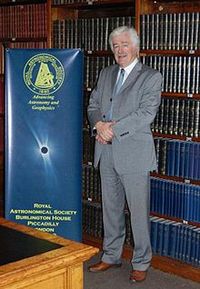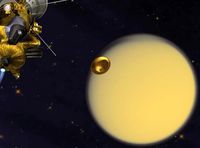 It was just as well there were plenty of savvy IT experts in the auditorium; Prof Southwood’s presentation would not open on his laptop. But after exhausting the logical possibilities, the sound techician logged-out and logged-in again, waited a near-eternity to catch the speaker's attention from an improptu time-filler talk he'd embarked-upon, we were ready to proceed.
It was just as well there were plenty of savvy IT experts in the auditorium; Prof Southwood’s presentation would not open on his laptop. But after exhausting the logical possibilities, the sound techician logged-out and logged-in again, waited a near-eternity to catch the speaker's attention from an improptu time-filler talk he'd embarked-upon, we were ready to proceed.
As far back as 1982, Prof Southwood recalled, he was present at the meeting at which the Cassini mission to Saturn stemmed. David remembers the date well – June 30th –his birthday. David was founder of what became the Space and Atmospheric Physics group, part of the team arguing for a ‘bolt on lander’ which eventually would be funded by ESA as NASA was reluctant to do so.
 The lander was not destined for Saturn, but its mysterious and largest moon Titan. Huygens was born. Prof Southwood was also leader of the team which developed the magnetometer on the main Cassini spacecraft.
The lander was not destined for Saturn, but its mysterious and largest moon Titan. Huygens was born. Prof Southwood was also leader of the team which developed the magnetometer on the main Cassini spacecraft.
In 1996 Cassini was finally launched, the largest planetary probe to be sent into space.
In May 2001 David became Director of Science at ESA, and under his directorship oversaw 3 low cost ESA planetary missions; Smart 1 and Mars Express in 2003 and Venus express in 2004. The same year, in June, Cassini finally reached Saturn. 2004 also saw the launch of ESA’s ambitious Rosetta mission to comet 67P. It was a busy time for David.
Back at Saturn, Cassini had to undergo a very risky manoeuvre in order to enter the correct orbit – a ring plane crossing – twice! David recalled how the tense the control room was at the time, the date, June 30th. On Christmas day 2004, Huygens was jettisoned from Cassini, taking 3 weeks to reach Titan, no communications were possible during this period before it arrived on Jan 14th. It then survived the 2 hrs 27minute descent through Titans hazy atmosphere, landing on the frozen surface.
Titan is Saturn’s largest moon and second largest in the solar system and has a substantial atmosphere, the pressure being 50% more than Earth’s composed chiefly of nitrogen, hydrogen, carbon and methane, but not much H20. On Titan itself methane exists at the triple point, similar to how water exists on earth, taking the form of a gas, solid or a liquid. Huygens had to be designed for any eventuality on landing. Oxygen is frozen out on titan, not leached out like on earth 1 billion yrs after its formation. Titan is therefore similar to a primordial earth, so the opportunity to study such a world, conducting real science, even for a short period, was too good to miss for the small increase in weight of the Cassini mission. The mission wasn’t flawless, one of the cameras malfunctioned, but Huygens did transmit for 72 minutes before contact was lost, data which is still being analysed today.
It turns out Huygens landed on a methane shoreline, it remains the most distant standing artefact built by humans- something Prof Southwood is very proud of.
In 2008, Southwood became ESA’s first Director of Science and Robotic Exploration, before retiring from ESA in 2011 becoming president of the Royal Astronomical Society 2012-2014.
Rosetta finally reached the wonderfully shaped comet 67P in Aug 2014, David joked if they had known the actual shape of the small comet before launch, and they would not have contemplated setting down a Lander on its surface. As it was they were there, so why not have a bash. As we know in November of 2014 Philae made it...just, touching down 3 times before coming to rest, lodged in a crevice, the first manmade artefact to land on a comet. It was another proud moment in David’s life.
David then showed several images of various dignitaries, including the French president, meeting and greeting various ESA scientists involved in the Rosetta and Philae mission. Yes, it was big news in the UK, it was even bigger news on the continent, considered a really significant milestone for ESA and scientific exploration in general.
As director of science at ESA when Rosetta launched, David insisted that a small micro disk was fixed to it, for at the end of Rosetta’s mission to study 67P, Rosetta was destined to become the 2nd artefact to ‘land’ on a comet, its last journey. Etched on the micro disk is the 1st chapter of Genesis of 3 religions in 1000 languages and dialects – a 21 century Rosetta stone.
- Log in to post comments

